Spreading the LUV: A brief history of Detroit’s mini-trucks
What better way for a gearhead to celebrate Valentine’s Day than with tiny trucks that make you say “aww”? We originally published this story in the summer of 2018; it’s back because LUV lasts forever. –EW
It might be hard to imagine, given the current, cutthroat state of the pickup truck segment, but there was once a time when these task-focused haulers were largely an afterthought to the bean counters in Detroit. Fifty years ago, before King Ranches and Longhorns lined their interiors with enough leather to reach from Lansing to Laredo, trucks were barebones affairs built to get the job done and sold to customers who honestly weren’t expected to use them as daily drivers.
An even more hands-off approach was applied to the burgeoning compact-truck scene, which caught the Big Three completely off-guard at the beginning of the 1970s. General Motors, Ford, and Chrysler had essentially ignored the small pickups being imported by Toyota and Datsun throughout the previous decade, blissfully ignorant of the fact that a growing cohort of buyers was willing to take a chance on a “foreign” brand if it meant an easy-to-drive truck that offered decent practicality and a low purchase price. In fact, it’s safe to say that Datsun (now Nissan) carved out its first important foothold in America by way of its 320/520 series of mini-trucks.
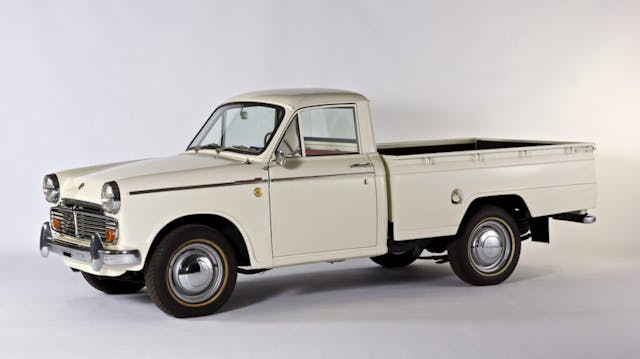
Scrambling to capture a demographic they hadn’t even known existed, Michigan’s best minds had to come up with a compromise, and quickly, until they could marshal the resources required to develop their own homegrown trucks. The result was a series of captive imports rebadged to battle the best that Japan had to offer … with the best that Japan had to offer. Each automaker was able to avoid the egregious 25-percent “Chicken Tax” by importing its rigs in chassis cab configuration for final assembly stateside.
Let’s take a look at the trio of mini-trucks fielded by Detroit for that awkward 10-year stretch that lasted right up until the likes of the Ranger and S10 took over the reins.
Chevrolet LUV
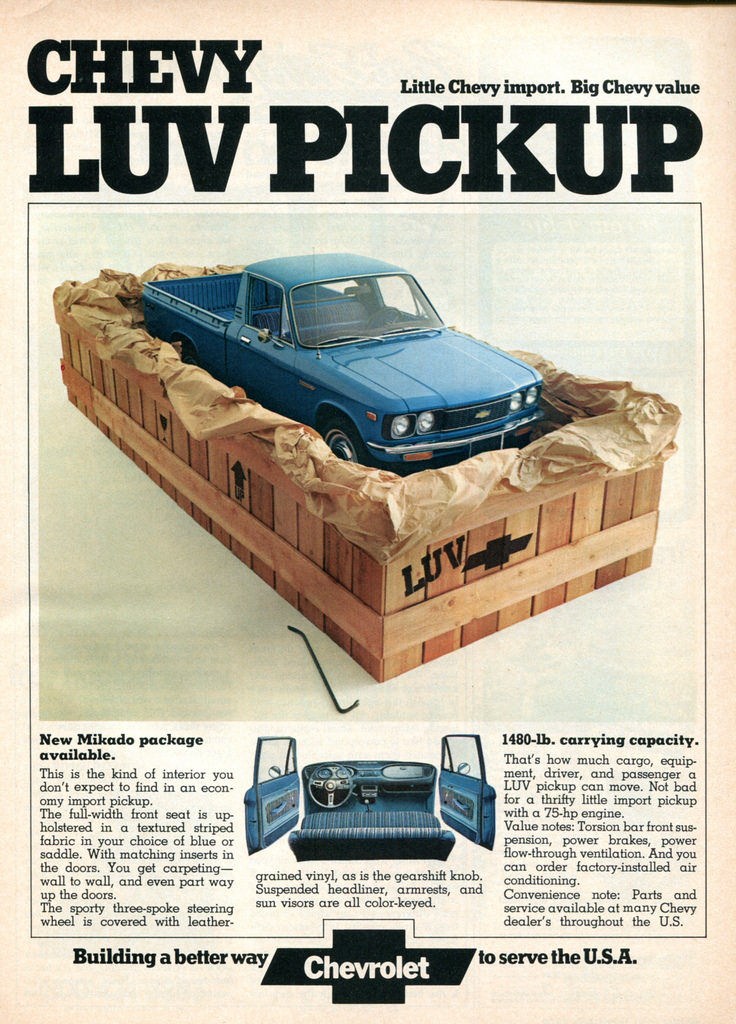
GM’s ace in the hole when it came to dealing with the nascent mini-truck madness was that it owned a sizable chunk of Isuzu. After a few terse phone calls, Chevrolet had its first compact truck ready to go, sent across the Pacific in droves to America where it would receive both the Bowtie and the unusual “LUV” badge, an acronym for Light Utility Vehicle.
The LUV was as basic as you could get when it appeared in 1972, offering a 1.8-liter, 75-horsepower, four-cylinder engine; four-speed manual gearbox; and 88 lb-ft of shrub-pulling torque. With a 102.4-inch wheelbase and 1400 pounds of cargo capacity, Isuzu’s finest was a paragon of pint-sized practicality.
In 1976, the LUV would gain a three-speed automatic and front disc brakes. By the end of the decade it was possible to snag a chassis-cab version of the truck, choose between 6- and 7.5-foot bed lengths, add four-wheel drive, and benefit from an additional five horsepower from an upgraded four-banger. A number of styling changes would also come and go with the Chevrolet, including a switch from quad headlights to a simple pair in 1978.
Chevrolet was strategic in spreading the LUV, making the truck available first in parts of the country where buyers had already demonstrated significant interest in smaller pickups. As a result, the LUV sold in huge numbers, with sales shooting from just over 20,000 in its first year all the way to a peak of more than 100,000 in 1979.
The second-generation truck that appeared in 1981 adopted styling that resonated with fewer buyers, but it wouldn’t matter that sales were cratering because the S10 was right on the horizon—and besides, Chevy had little to complain about having moved 462,000 LUV units since the model was introduced. Not bad for a segment that no one saw coming.
Ford Courier

The Ford Courier was another example of an American institution leaning on a Japanese partner to fill a hole in its product planning. In 1972, Mazda was already selling the B1600 in the United States (and had been offering the more powerful B1800 in Canada since 1970), but it hardly minded when the Blue Oval strong-armed its way into the mini-truck mix by rebadging the B1600 as the Courier. Besides, Mazda had the Rotary Pickup waiting in the wings, so what did it matter if Ford wanted a few thousand piston-driven trucks in the meantime?
Ford took a more aggressive approach to updating the Courier than Chevy did with the LUV, at least when it came to drivetrain choices. Whereas the LUV would stick with its original powerplant throughout its entire production run, the Courier’s initial 1.8-liter four—with 74-hp and 92 lb-ft of torque—was eventually complemented by a roughly 90-hp, 2.3-liter option lifted from the Pinto (for its 1977 redesign), and then replaced entirely by a 2.0-liter mill (in ’79).
Ford also made a three-speed automatic available alongside the truck’s standard four-speed manual right from the start, adding a five-speed option in 1976. Strangely, despite the ostensibly identical Mazda delivering 2250 pounds of cargo capacity, the Courier matched the LUV with an advertised 1400-pound carry rating.
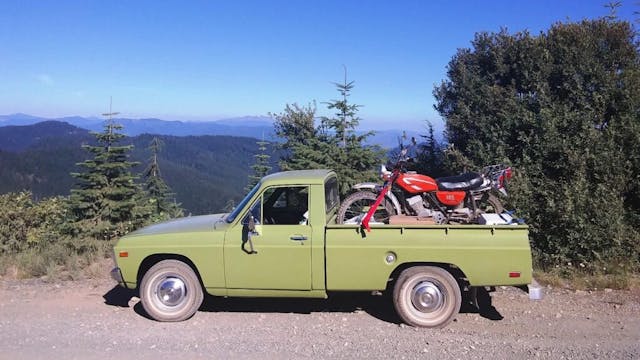
Other changes throughout the decade included the unusual decision to lengthen the cab by three inches in 1976, one year before the second-generation model debuted. Also strange was the availability of third-party four-wheel drive (most notably under the Courier Sasquatch name) in the absence of a Ford-developed system.
If you’re an EV historian, then you’ll also be intrigued by the ultra-rare Jet Industries ElectraVan 750, a battery-powered version of the Courier that offered 60 miles of range on a single charge.
The Courier would survive until 1982, when it was retired in favor of next year’s iconic Ranger.
Dodge D-50 / Plymouth Arrow
20180716162248)
Chrysler leaned on its long-standing history with Mitsubishi when it came time to tackle the surging mini-truck threat. Unlike Mazda and Isuzu, however, Mitsubishi was pickup-poor throughout most of the ’70s, leaving the Pentastar on the outside looking in at all of the action being soaked up by Ford and GM.
It wasn’t until 1979 that Dodge would import the Mitsubishi Forte, which had gone into production the year before, relabeling it the “D-50.” Deciding that the best way to make up for lost time was to double its efforts, Chrysler also tagged Plymouth into the pickup game with the Plymouth Arrow, which was identical to the Dodge.
With a wheelbase seven inches longer than that of the LUV, and featuring a choice of engines delivering between 93 (from a 2.0-liter four) and 108 (from 2.6-liter four) horsepower, the Mitsubishi twins were certainly competitive. This was especially true when considering the larger motor’s 139 lb-ft of torque, and the availability of three, four, or five forward gears. Payload remained locked at the seemingly industry-standard 1400 pounds and was delivered by a 6.5-foot bed (with another 100 pounds of bed capacity added the following year).
In 1981, the D-50 would be renamed the Ram 50, and while the Arrow would disappear by 1982, the Dodge version would continue on for an astonishing 13 additional years (finally leaving the American market in 1994). During that time it would gain four-wheel drive, a four-door model (in addition to extended-cab versions), and endure a brief flirtation with diesel power.

Why did the Ram 50 endure? Truth be told, Chrysler was in total chaos in the early ’80s and had no money to throw at a dedicated compact-pickup platform. While Ford fans and Chevy loyalists were enjoying the Ranger and S10 for the 1982 and ’83 model years, Mopar maniacs were instead gifted with the ultra-weird (and short-lived) Dodge Rampage and Plymouth Scamp, L-body front-wheel-drive haulers that had more in common with the Subaru Brat than they did a legitimate truck. These were followed by the unibody Jeep Comanche in the middle of the decade, which was itself joined by the mid-size, and full-frame, Dodge Dakota in 1987, creating a confusing-at-best situation at Mopar dealerships for much of the ’80s.
That confusion seems appropriate considering how long it took the Big Three to figure out there was a mini-truck market in the first place.
Check out the Hagerty Media homepage so you don’t miss a single story, or better yet, bookmark it. To get our best stories delivered right to your inbox, subscribe to our newsletters.

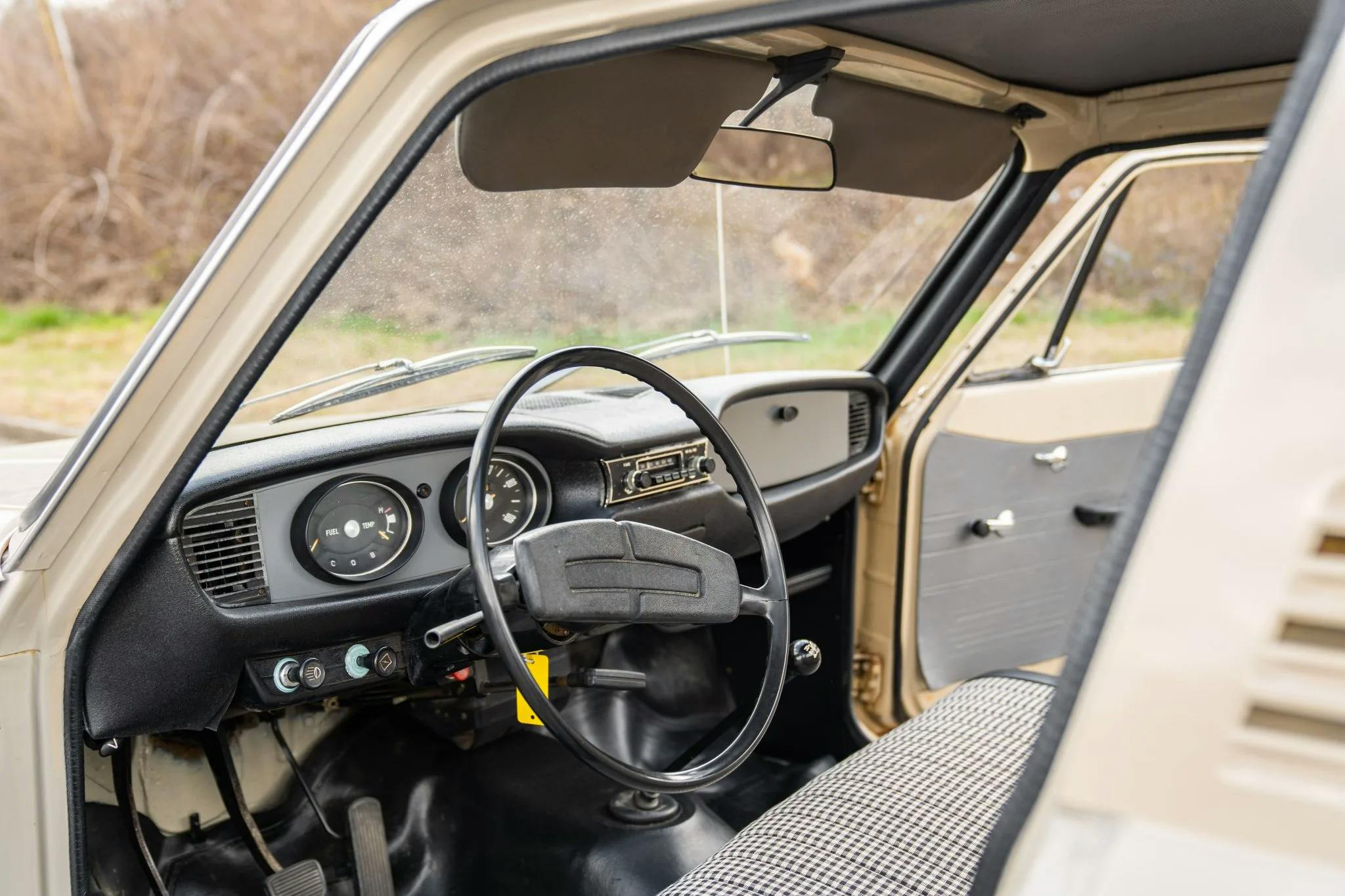
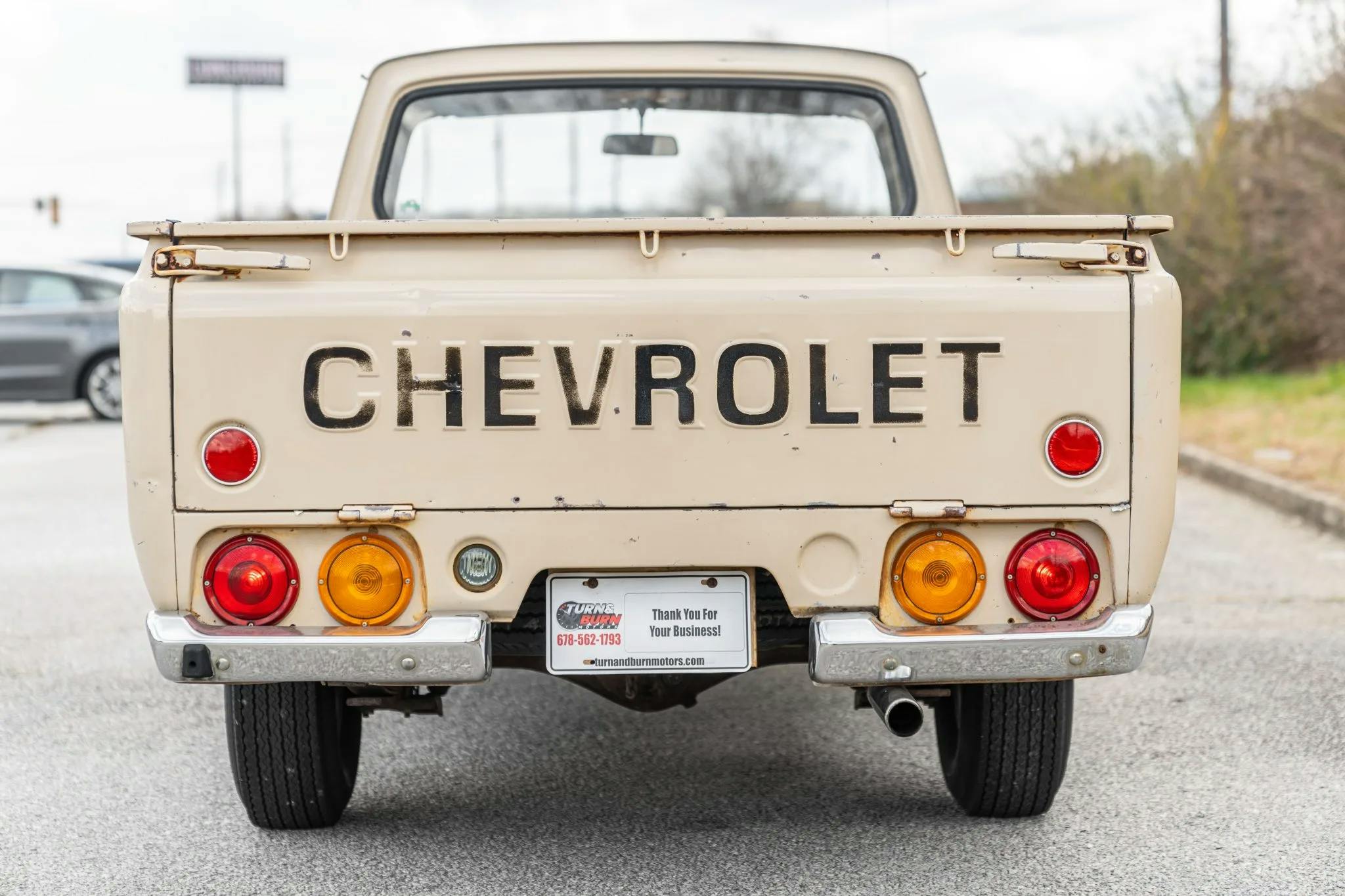

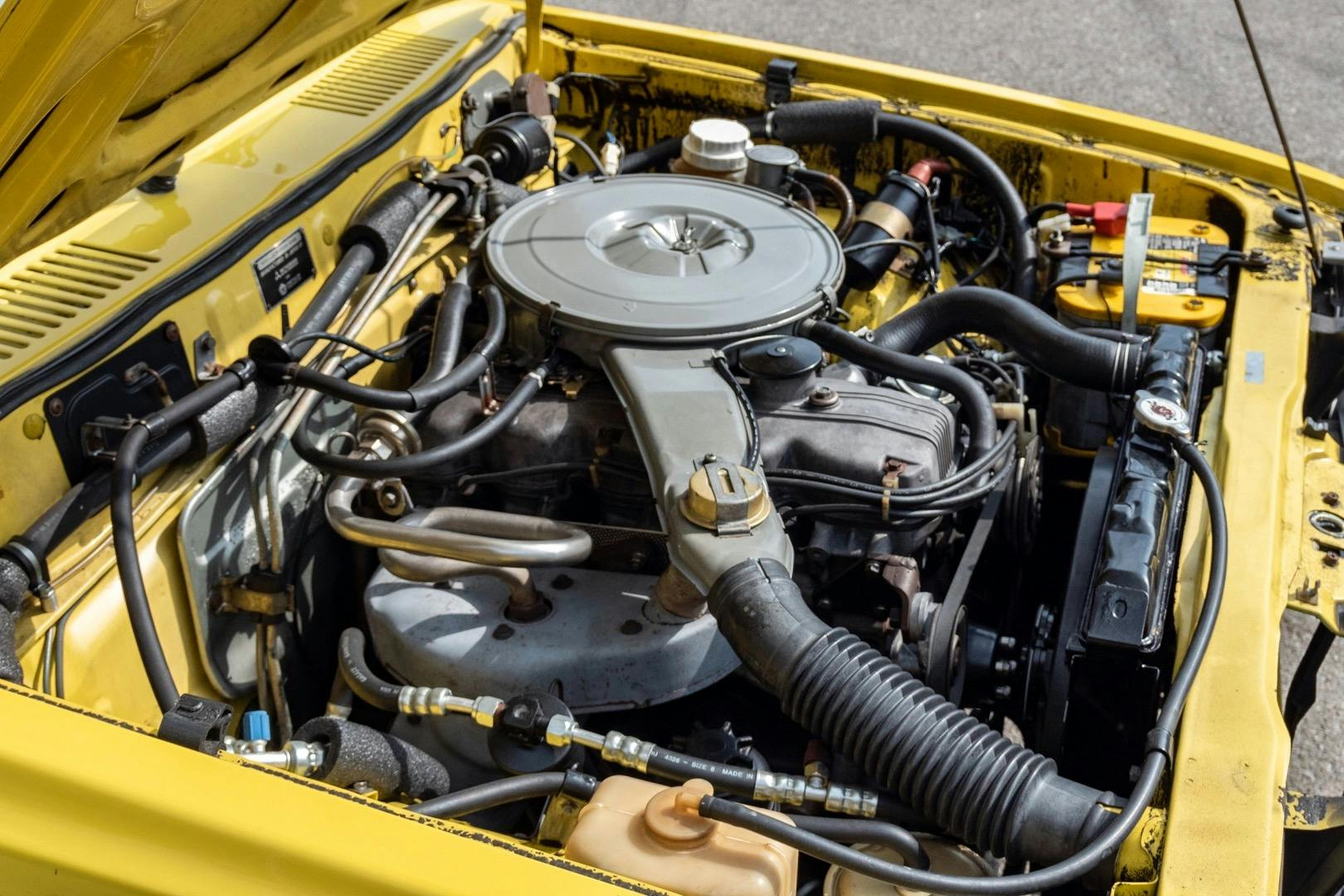

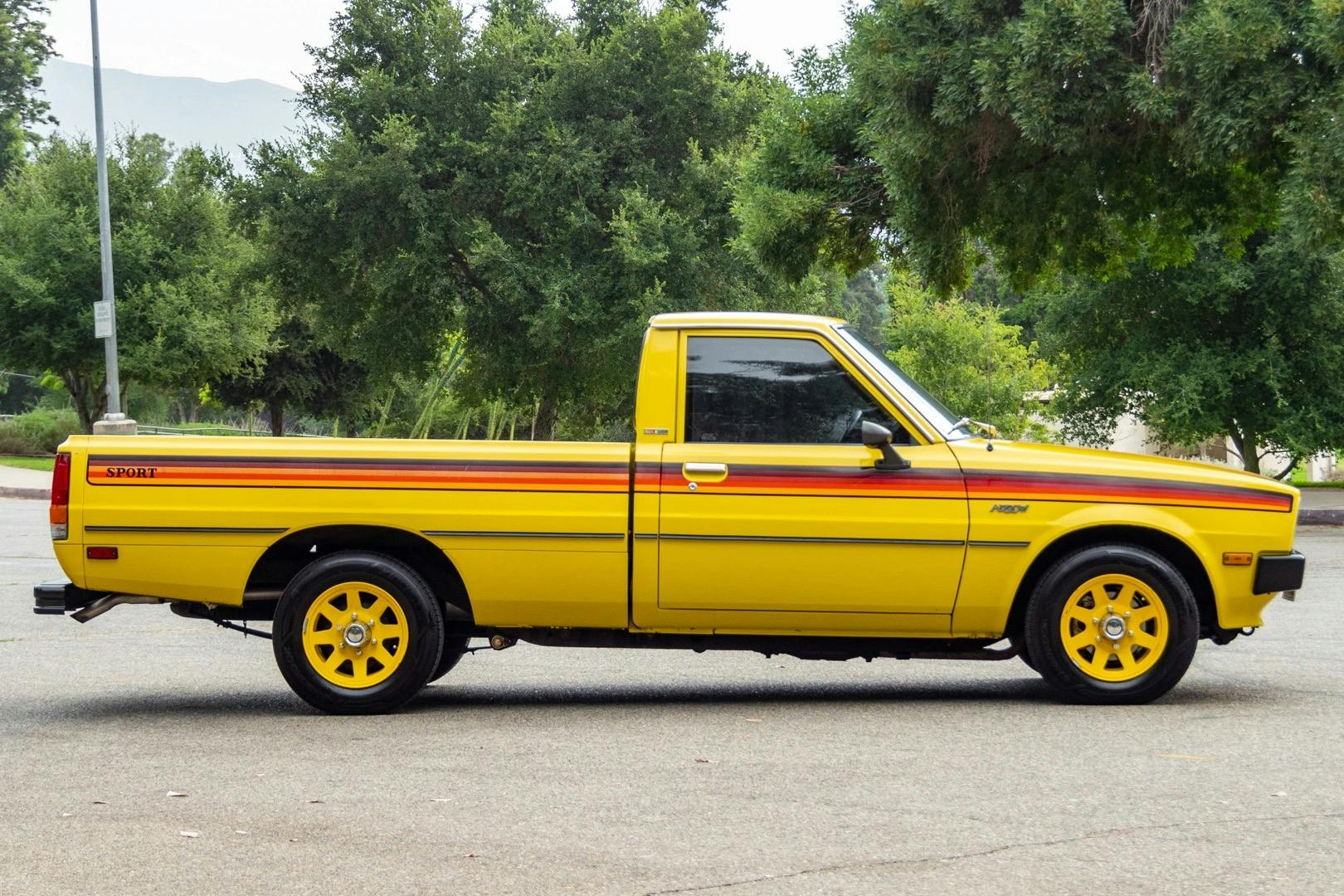





I had an ’80 Courier and really like that truck until it completely rusted apart (SE Michigan salted roads). They had no inner front fenders and rotted out like crazy.
Surprised at my age I don’t remember the Chevy Luv. Cool little truck.
Might have looked sweet but that early engine was junk.
I was referencing MJ’s comment. Those early Chevy LUV engines were junk.
Most of these had nothing to do with Detroit. These vehicles were extremely useful and right sized but doomed by the high profit margins and the skirting of emissions and safety regulations enjoyed by the oversized, wrong sized, full size, yet consumer-oriented (non) trucks.
Identify the regulations guiding these emissions standards purportedly aimed at light trucks.
They used to be everywhere; spent time in every example featured here. Handy, flickable, basic and reliable. Even more fun with a V8 swap, especially if you didn’t advertise it, heh heh…But not much in the way of protective structure against the overweight and jacked-up behemoths people drive today.
Bought a used 81 Isuzu 4×4 PUP (LUV) for $2500. Drove it for 10 years and sold it for $1500 with cold AC! They sure don’t make them like that any more GOOD and CHEAP !
This article is a reminder about the choices in small trucks that we had many years ago. Ford let the Ranger die on the vine in 2011 while continuously updating the F150 with the latest technology, and Ford’s story to the public was that everyone wanted full size trucks which was wrong. Toyota Tacomas have been very strong sellers for as long as I can remember. And, just go try to buy a Ford Maverick and see how strong the demand is.
Yeah, but the Tacomas are getting bigger and more complicated too. I have a 2010 model and love it. I’ll spend my money on keeping it running before I’ll buy a newer one.
I met a Ford engineer, who told me that there was about $200 difference in the cost to build a Ranger vs an F150 at the time. The 150 had a massively larger profit margin in final consumer cost. And, Ford needed the assembly lines to make more F150s, to meet demand. Market studies showed that buyers of Rangers were buying one instead of a 150, not creating additional sales. Simple internal economics killed the Ranger. The new Maverick was designed to fill a product void, and a specific price segment, while hopefully not poaching F150 sales, like the Rangers did. All from an internal Ford guy, and the pricing / product strategy is obviously working.
I have a bone to pick with that market research, as many a car dealer has told me that compact trucks (for many brands, not just Rangers) were bringing in new customers that couldn’t get financed on anything more expensive than something like a $10,000 truck. And it was still a truck, which many people preferred over subcompact hatchbacks. It kept customers in new car showrooms and out of sketchy used car lots.
Participants in market research studies aren’t usually forced to disclose their credit rating and how big of a loan they were approved for.
My mechanic was selling one of those Dodge Ram Jr’s years ago. I think it was a 1991 4wd model. He had a mild lift on it with alloy wheels and off road lighting. It looked pretty cool and drove like a little tank. He loaned it to me for a few days, but in the end I decided against it. Dodge and Mitsubishi…not bastions of reliability.
I’ve seen one of these LUV trucks before and had never heard or seen one before. The one I’ve seen has a 350 stuffed in it.
My uncle bought a Dodge D-50 brand new but did not know much about it. He was pissed off when he got home and opened the hood and found Japanese writing all over the place! He was a UAW man.
The first new vehicle I bought at 18 was a 1976 Chevy LUV. Enjoyed it’s practical nature and it was always fun to drive.In fact I still own it today and have done a complete restoration on it over the years.Also owned a 1981 4×4 model and drove it all over the country even up to Alaska camping under the cap the whole time.A simpler vehicle for a simpler time. It was a very reliable little truck and with a few hot rod tricks (dual carbs, intake, and exhaust header )kept up on the highway just fine.
I bought a new 1979 4×4 Chevy Luv 43 years ago since I wanted a cheap economical truck. Another incentive was that stupid hard to diagnose fuel injection stuff was really coming on strong. Knowing I could keep a carbureted vehicle with points and condenser going forever it was an easy choice to make. No regrets in 145,000 miles. Got me home EVERY time I had it out. Had the seat reapholstered and I kept up the washing and painting so it looks like new. Still has the original clutch. I got many cords of wood home to burn without much investment in gasoline.
All 3 trucks had a diesel engine option.
Benjamin Hunting’s comment re the Chevy LUV : “… and 88 lb-ft of shrub-pulling torque” was laugh-out-loud brilliant !! Almost spilled my bourbon !
Great article – cheers !
What about the chevy s10? I have a 93 ex cab 2 wd v6 and 5 speed. It has only 79k miles and highway 30mpg. I love this little truck.
My dad had a 1st gen S10 with a V6/5 spd. It got 16 MPG whether it was in town or on the highway. He always complained about it, but kept it for many years.
S10 GmC S15 reliable,fun economical 1 Shifting up-and-down on the back country roads.Rock and roll!@@
These trucks not only look good, they’re economical, easy to drive/park and have larger beds than today’s mostly 5ft bed “monster trucks”. I love my 2003 Ranger which has the same basic proportions/design as these. I would not exchange it for a brand new full size even if they gave it to me for free.
My ’96 Ranger has 381000km on it -4 liter OHV 5 speed manual – 7 foot box and standard cab. Like MG D I’d be hard pressed to trade it even for a brand new fullsize – or even a brand new Ranger!!! I hope to still be driving it in 5 years.